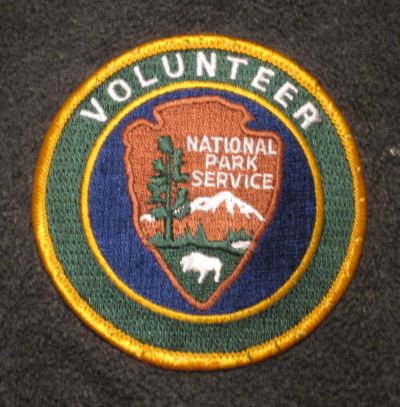 Experiences
as a Campground Host
Experiences
as a Campground Host 
 Experiences
as a Campground Host
Experiences
as a Campground Host 
Phill Vanderschaegen
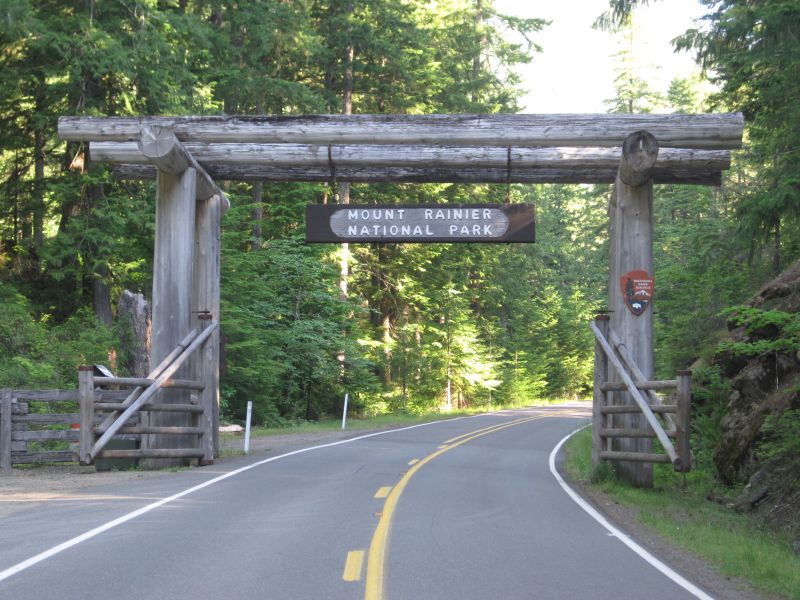
From July to October 2010 I volunteered as a campground host at Ohanapecosh Campground in Mt. Rainier National Park. I worked closely with the campground staff in the daily operation of the campground. In exchange for my labor I was provided a campsite with full hookups (water, electricity and sewer) for my travel trailer. This is a beautiful place to work and enjoy the park. My normal work days were Monday through Thursday. This was a very enjoyable time for me, the following information details my experiences at Ohanapecosh (aka Ohana).
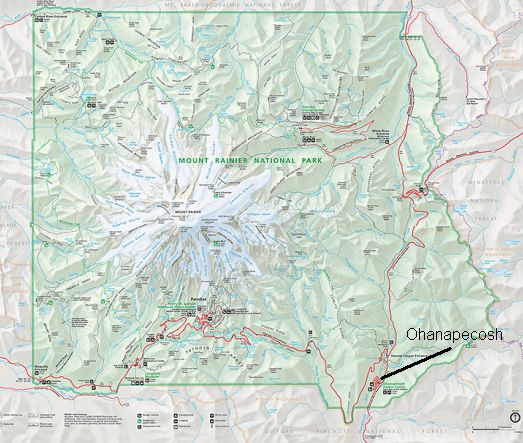 Rainier
National Park map showing Ohanapecosh in the southeast corner.
Rainier
National Park map showing Ohanapecosh in the southeast corner.
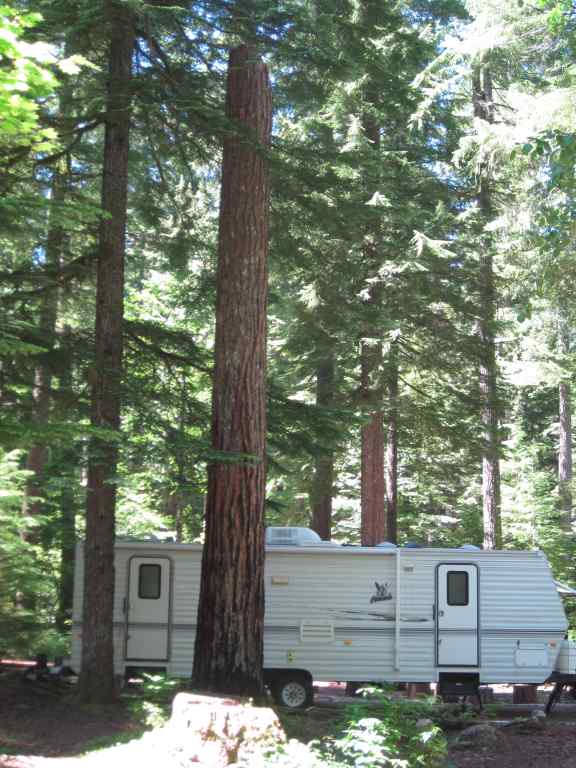 My
trailer in the host campsite.
My
trailer in the host campsite.
Ohanapecosh Campground is in the southeast corner of Mt. Rainier National Park. The campground is 12 miles north of Packwood, Washington off Highway 123. Ohana Campground is located along the Ohanapecosh River in an old-growth forest. Large Douglas-fir, western hemlock and western red cedar dominate the forest. The campground is about 1900 feet above sea level and is overshadowed by Backbone Ridge to the west. The campground is generally open late May through early October. I arrived on July 7th because I had some obligations in the early summer.
Ohanapecosh
River looking upstream from the campground bridge.
There are approximately 190 campsites at Ohana. I say "approximately" because at various times campsites may be closed due to hazards, mainly trees. The massive flood of November 2006 actually caused the permanent destruction of a few campsites along the river. The campsites are arranged in loops, with Loops A, B and C on the east side of the river and Loops D, E, F, G and H on the west side of the river. Here's a campground map. There are not a lot of long RV sites at Ohana, there is a limit of 27 feet for trailers and 35 feet for motorhomes. There is a RV dump station available in B Loop. Campsites in most loops (A through F) are available for reservations. Campsites in G and H Loops are on a first-come-first-served basis. The campground host site is located at the start of Loop B near the Comfort Station. The river is only about 100 feet from the host site and it is a short walk to the bridge over the river. Part of my morning ritual was to walk over to the bridge and look at the river and surrounding ridges. The forest is so thick that I could not see the sky from my campsite, so I needed to go to the river to see the sky above the ridges. Backbone Ridge acts as a cloud capturing topographic feature and I would check it every morning to try to get some idea of what the weather was doing.
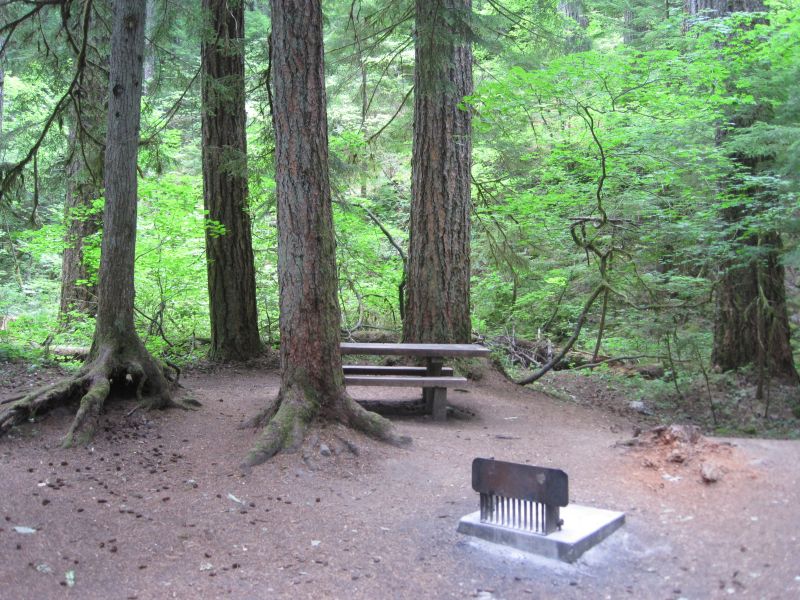 A
typical Ohanapecosh campsite with table and fire pit.
A
typical Ohanapecosh campsite with table and fire pit.
Each of the loops has a Comfort Station. There are, unfortunately, no showers. Every campsite has a picnic table and fire pit. During the summer the campground is mostly full during the weekends. Monday through Wednesday there are many open sites in all loops. On Thursday campers start arriving for the weekend. I was surprised to see that most of the campers are from the State of Washington. British Columbia and Oregon also are well represented in the campground. Foreign campers tend to be represented by the Netherlands mostly. I encountered a group from Belgium who were familiar with my Father's birthplace.
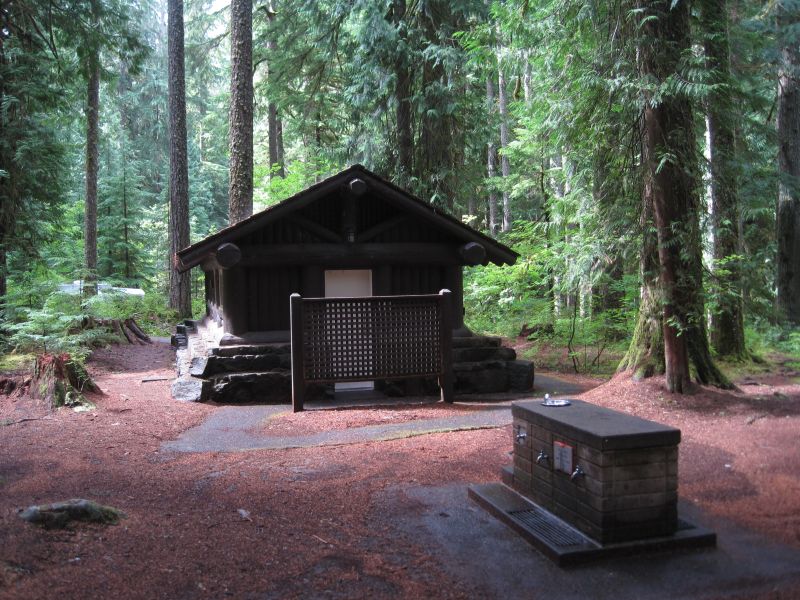 This
is a typical Comfort Station with access to water for campers.
This
is a typical Comfort Station with access to water for campers.
The Ohanapecosh River Valley is covered in old-growth forest. The area immediately to the north of the campground is the site of a hot spring where a resort was located until 1963. Occasionally visitors will still show up at Ohana looking to bathe in the hot springs. Currently there are no pools of hot water at the springs and swimming is only allowed in the river. By the way, the river is around 43 degrees (F), nowhere near a hot spring experience. I have a few of my river photos here.
The campground forest consists of mostly Douglas-fir and western hemlock in the overstory. These trees are around 200 feet tall and the canopy is almost completely closed except over roads and parking areas. I measured the diameter of a number of Douglas-firs and the bigger trees were in the 4-6 foot diameter range. Most of the trees appear to be around 200 feet tall. Western red cedars are also found in this area, but not as common as Douglas-fir or hemlock. Along the river red alders grow and vine maple is common in the understory. Red alder is common along the river edge and in other wet sites. There are only a very few big-leaf maples to be found. The Douglas-fir appear to be reaching maturity and downed trees are common on the forest floor.
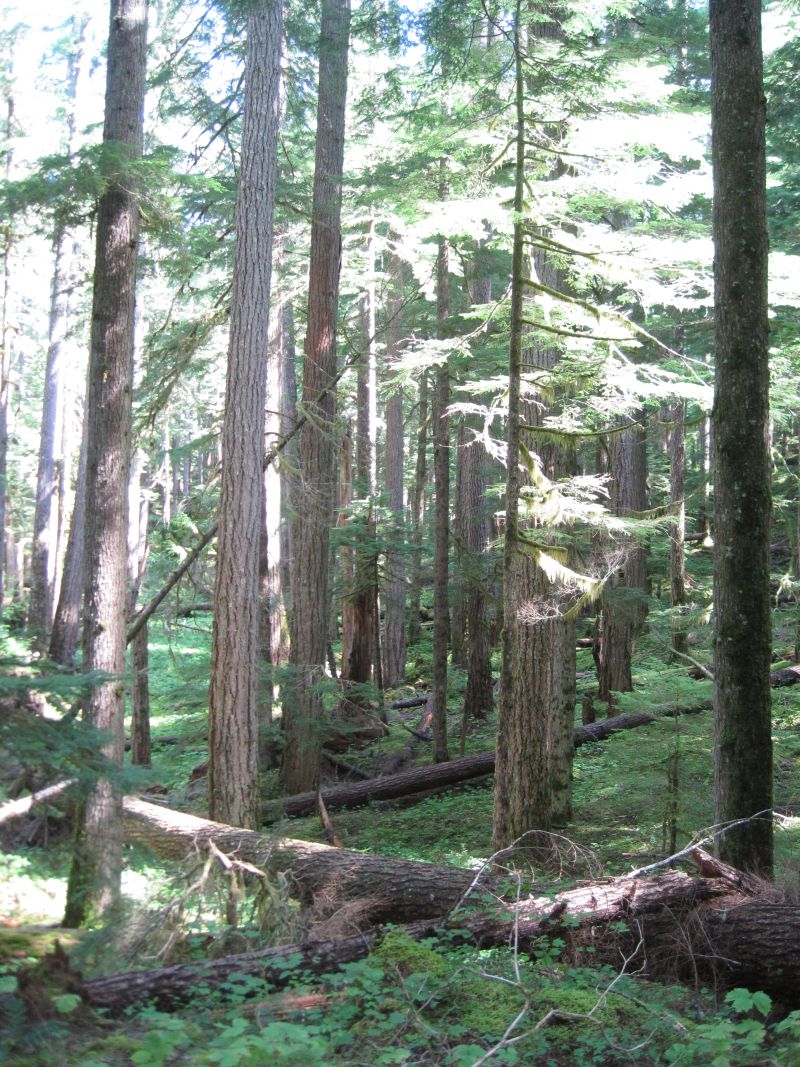 This
is what the forest around Ohanapecosh Campground looks like. Note the flecks
of sunlight, most of the forest floor is in the shade.
This
is what the forest around Ohanapecosh Campground looks like. Note the flecks
of sunlight, most of the forest floor is in the shade.
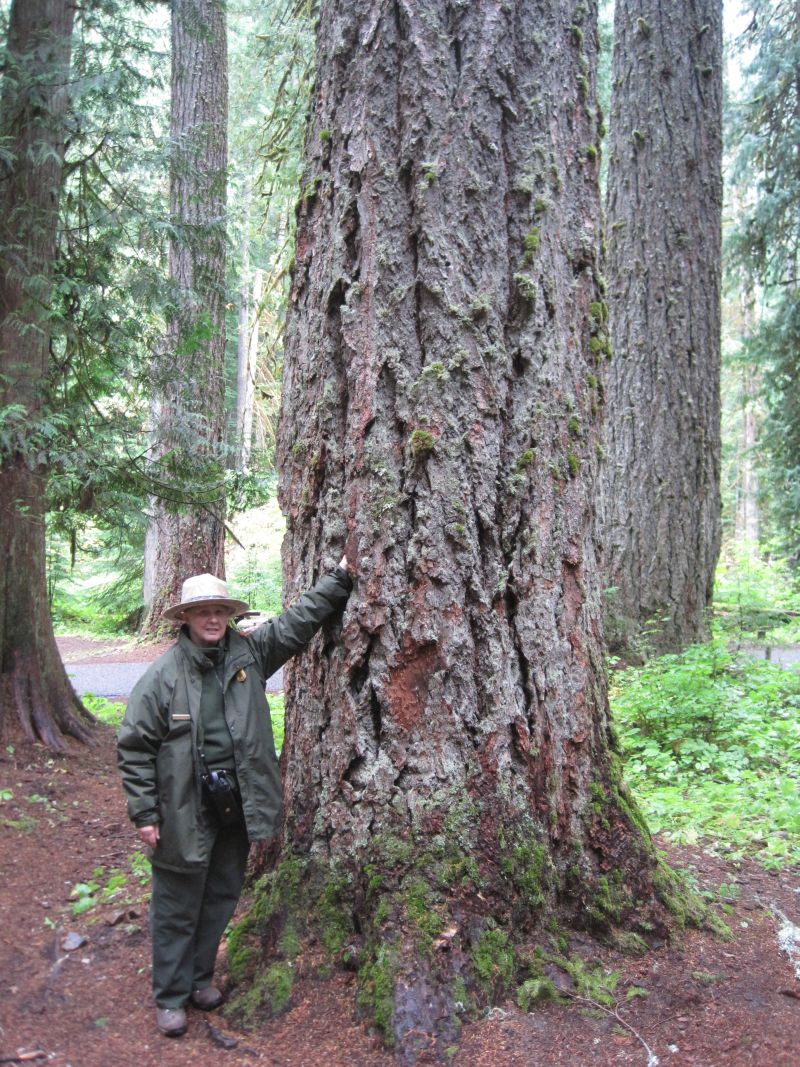 Campground
Ranger, Darlene, with one of the big Douglas-firs in the campground.
Campground
Ranger, Darlene, with one of the big Douglas-firs in the campground.
The forest outside of the immediate campground area is still in a very natural condition. However, in the campground the forest has suffered from the effects of campers. The understory is reduced and the ground cover is trampled. Campers gathering wood have cleared out much of the areas within the campground loops. Red huckleberries are common within the campground as are Oregon grape plants.
There are two trailheads in the campground, one on each side of the river (Silver Falls Loop Trail). Both trails take you to Silver Falls, which is one mile upstream from the campground. There are three branches off these trails: one to Laughingwater Creek Trail (on the east side), another to the Cowlitz Divide Trail (on the west side) and a third which leads to the Grove of the Patriarchs about one mile north from the falls. These trails take you through more beautiful old-growth forest with a wide variety of flowers, mushrooms, ferns and mosses. There is a footbridge connecting the two trails at Silver Falls with great views of the falls. Here is the trail map for the Ohanapecosh area.
Mt. Rainier itself is not visible from Ohana campground. I had to drive to either Stevens Canyon Road or Sunrise to see the mountain. Mt. Rainier National Park is a BIG place and is administratively divided into the east and west sides. Paradise on the west side is probably the best known place in the park. I avoided the Paradise area because of the crowds. I did all of my hiking on the east side of the Park either around Ohana or in the Sunrise area.
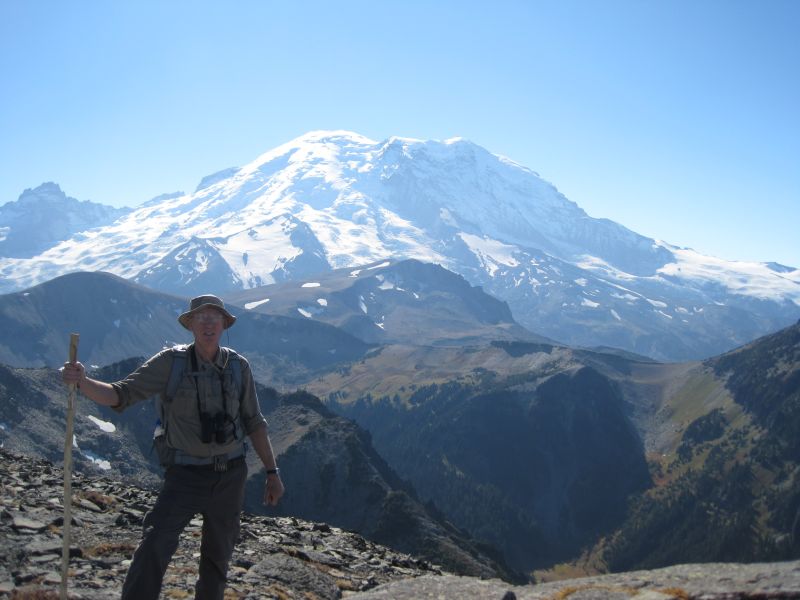 Here
I am on the trail to the Mt. Freemont lookout on the north side of the mountain.
Here
I am on the trail to the Mt. Freemont lookout on the north side of the mountain.
There are no commercial services available in the Ohana area. The town of Packwood is the nearest place where groceries, gas stations, hardware, library and other services are available. There is a single small IGA grocery store (Blanton's) and an Ace Hardware in Packwood. I was able to get Verizon cell phone service in and around Packwood, however my ATT cell phone did not work anywhere in the Packwood area. For dental services I had to drive down to Randle and the nearest medical services are in Morton.
Other cities within driving range are Enumclaw and Yakima. I drove to Enumclaw to do some shopping, but I did not get to Yakima. The urban Seattle area is roughly 100 miles away and the Vancouver/Portland is about 150 miles to the southwest.
The Park Service requires 32 hours/week from a campground host. Normally I worked from 8AM to 5PM Monday through Thursday. I could be visited at anytime by people needing help since I was camped in the campground with a sign identifying me as the campground host. I also worked on my days off if there was a need or I simply felt like doing something.
The majority of my work hours was spent with the campground rangers doing the normal day-to-day operations of the campground. It takes quite a bit of effort to run a campground the size of Ohana.
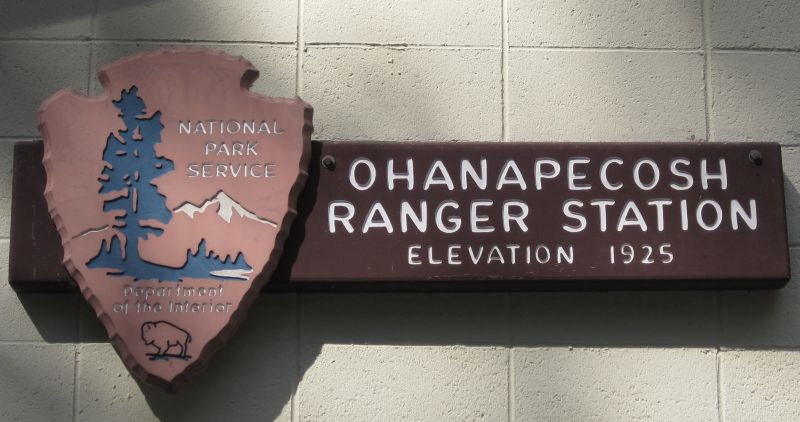 The
base for our campground operations was the Ohanapecosh Ranger Station.
The
base for our campground operations was the Ohanapecosh Ranger Station.
During most of the camping season reservations are taken for most of the campsites. Every day reservation cards need to be prepared for incoming campers, these cards then need to be delivered to the posts at each campsite and cards need to be picked up at those sites where campers are leaving. Reservation cards are picked up and delivered to sites during campground rounds. The rangers do the rounds in the GEM car 3 or 4 times per day. During rounds campsites are checked for proper registration, rule violations, as well as answering camper questions. The work schedule is usually arranged so that at least two rangers are working any given day. The work hours are staggered so that one ranger starts early in the morning and the other starts later and works in the night. My hours meant that I was working with the daytime ranger most of the time. I was very lucky to work with Darlene most of the time. Darlene had worked as the campground host before she became a campground ranger. This meant that she knew campground operations inside and out and knew what I needed to do. Her help made my transition to campground operations easy and we seemed to work well together. The largest part of my time was working on the rounds with the rangers. The second most common work activity was picking up trash.
Reservation
cards ready to be placed at campsites.
Here's
Darlene and Martin, Campground Rangers, making rounds in the GEM car.
The campers at Ohana were very good about keeping their campsites clean; they left behind few large pieces of trash. However, there were always some small pieces of trash (napkins, plastic utensils, etc.) and a lot of "micro trash". The most common micro trash was plastic bag closures and cellophane wrappings from drink straws. Most weeks I would walk the entire campground twice (usually Monday and Thursday). There are three miles of road in the campgrounds and my walking was not confined to the roads. I would walk through most unoccupied campsites; I estimate that I walked four miles on a good day. While picking up trash, I also kept an eye open for any other issues in the campsites such as nails and ropes in trees, improperly stored food, lost items, rocks in firepits and others. Also, while walking through the campground campers would ask questions. When I first got to Ohana I did not know much about Mt. Rainier. With the help of the Interpretive Rangers in the Visitor Center and others I soon learned enough to answer most common questions. I was always identifiable as a Park Service Volunteer with my cap and/or shirt and jacket with volunteer patches. The Park Service also gave me very nice name badges. I also had a Park Service radio hanging off my belt which helped identify me as an employee.
By the end of the camping season, as the Park Service employees began to leave, I was occasionally the only person working in the campground. The number of campers at this time was low and I knew the routine so it was not difficult to take care of the campground.
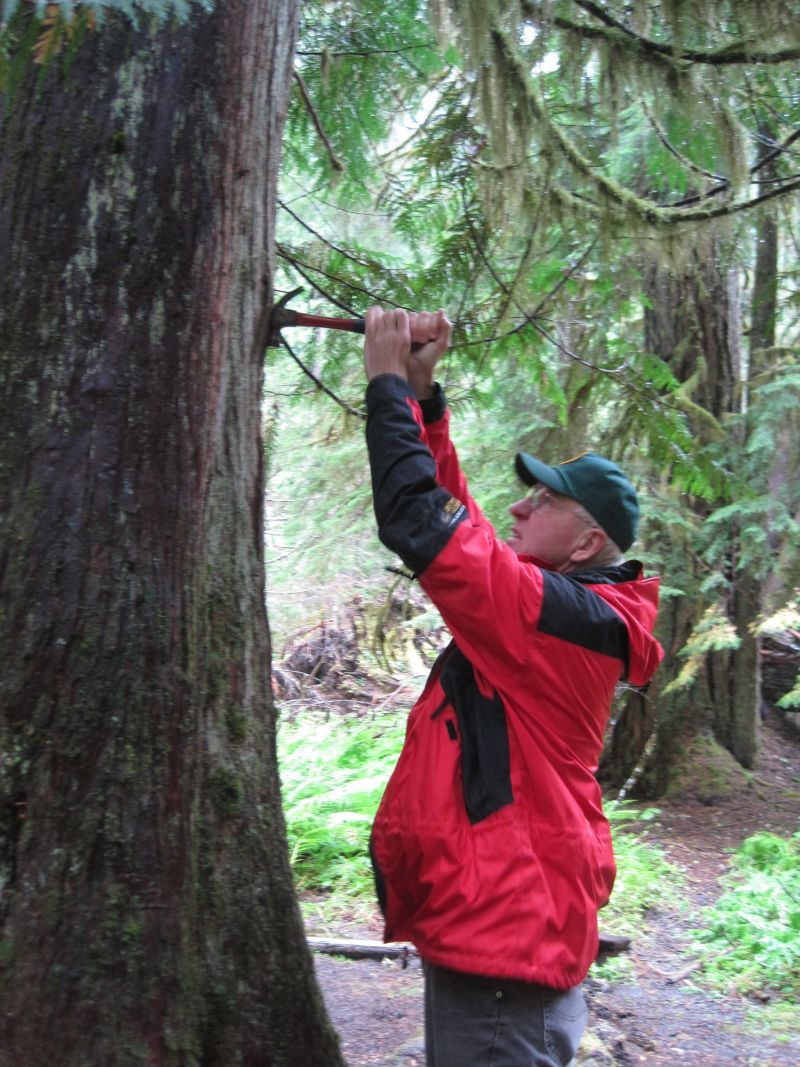 Here
I am pulling a nail from a cedar.
Here
I am pulling a nail from a cedar.
As with any job, other duties needed to be performed when unusual events or circumstances cropped up. For example, all the roads in the campground were resurfaced during the summer. As the resurfacing was being done I worked with the contractors in getting visitors through the construction mess and helped with cone placement and removal. I also helped maintenance by installing food storage warning signs on picnic tables. The most unusual thing I had to do was locate some campers who had a death in their family. I was a bit apprehensive about this, but everything went fine.
Resurfacing
the main road in the campground.
On several occasions I had to deal with visitors disturbing their neighbors at night and there was one incident when several guys were wandering around disturbing campers while attempting to find the hot springs in the dark. These guys thought they could get into the springs and enjoy a dip. They were probably a bit drunk also. All of these events were resolved.
A few campers arrived at the campground without some needed equipment. I loaned out leveler blocks, camp chairs, salt and other items. In all cases the campers returned the stuff I loaned them
On July 12 a 203 foot tall Douglas-fir fell in Loop G. This tree fell across campsite G2 (see photo below)and across the road. We had to close several campsites and control access while the trail crew cut down the other trees that were damaged.
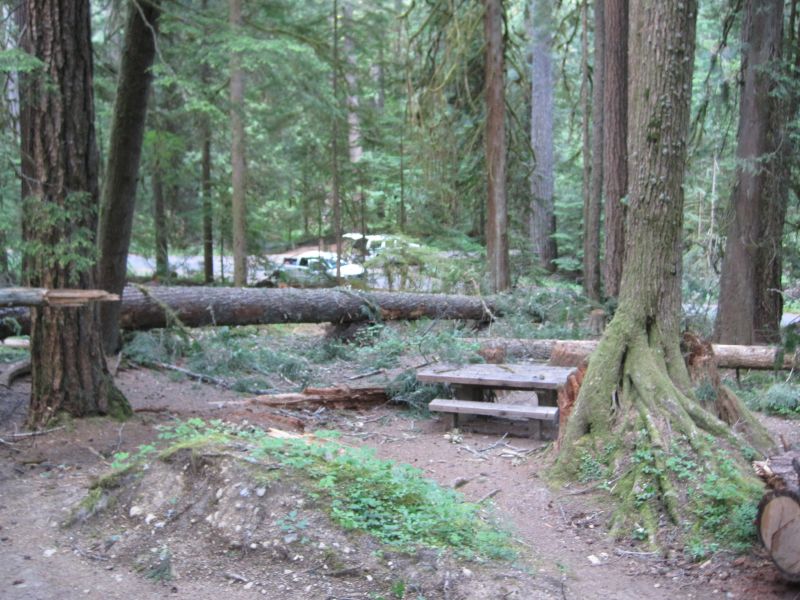 Downed
tree in campsite G2.
Downed
tree in campsite G2.
There were too many positives to fully enumerate, but I'll try. Probably the biggest positive was just living in an absolutely beautiful old-growth forest next to the clear Ohanapecosh River. I could even enjoy picking up trash in this environment. I had easy access to the entire east side of the Park and could hike many trails. The other main positive was the Park staff. I found all of the Park employees to be hardworking and very dedicated to public service. I worked mainly with the campground rangers and maintenance crew, but also interacted with the staff in the Visitor Center. Everyone did their best to provide service to visitors and protect the resources of the Park.
Staying at Ohanapecosh was a great way to save money. My only expenses were groceries, truck fuel and my cell phone bill. Since I was so far away from places to spend money the summer was financially a great experience. I had plans to explore outside of the Park before I got to Ohana, however I did not leave the Park much because there were enough trails and other things to do to keep me occupied without driving too far.
I had a parking place in my campsite that I could share with visitors. During my stay I had many visitors. My kids, sister and friends showed up to visit at various times. I had a birthday during my stay and both of my kids came out to help me celebrate. In the photo below my daughter and her boyfriend, my sister and my son pose with me at Sunrise, with Rainier in the background. It was a great birthday.

As a biologist, I had ample opportunity to search for wildflowers, mushrooms, birds, and other wildlife. Mt. Rainier biota and geology are infinitely interesting. I could easily get help from the Interpretive Rangers and I had access to a small, nice library in the Visitor Center. I got to read a number of books about the Park, the forests, plants and animals.
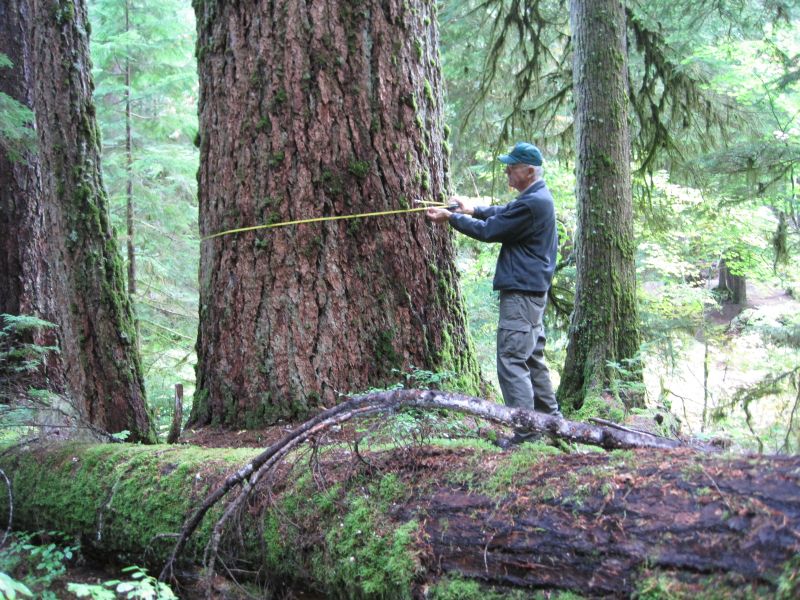 How
can you not be happy in a place where there are trees this big? The biggest
tree I measured was a 6'2" diameter Douglas-fir.
How
can you not be happy in a place where there are trees this big? The biggest
tree I measured was a 6'2" diameter Douglas-fir.
During September and October a large number of mushrooms appeared. I got to try several types of mushrooms that I never ate before. The Park employees helped me with my mushroom identification. I don't like to eat new mushrooms without being absolutely sure about the ID.
Staying at Ohanapecosh did have its downsides, however these were vastly offset by the positives. There is no cell phone service, no TV signals and my radios did not receive any good signals. This meant that I had to drive four miles to use my phone and check my e-mail. I arrived in the Park too late to receive the training necessary to get access to the Park Internet. My Verizon Internet was very slow in the Packwood area. Even the Packwood library Internet was slow.
All services were in Packwood, 12 miles from the campground. There was only one grocery store, with limited selection and much higher grocery prices. The park employees told me the first season at Ohana was the hardest, it takes a while to get used to living with little contact to the outside world. I'm a bit of a news junky so it was hard to adjust to the lack of communication. The hardware store had everything I needed (mostly mouse traps!). There are no clothing or big box stores within easy range of Packwood. I drove out to Enumclaw, Vancouver, WA and the Seattle area to get items that I could not get around Packwood.
I had to deal with a serious mouse invasion. The wild deer mouse population must have been very high as I trapped many mice over the three months I was in the campground. I also had one bushy-tailed woodrat invade my trailer. It was quite a surprise to look up from my book one night to see a completely unexpected woodrat staring at me from the kitchen counter. The next day I was able to capture him under my sink.
Almost every volunteer I've talked to was happy with their experience and encouraged me to volunteer. I would do the same, I encourage anyone with the time and wherewithal to volunteer. I'll continue to volunteer as long as I can. The volunteer program at the park has a blog. There is also information about volunteering on the Mt. Rainier web site. If you'd like to volunteer as a host at Mt. Rainier N.P. click here for the application.